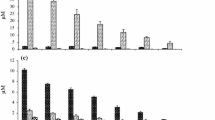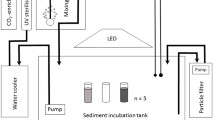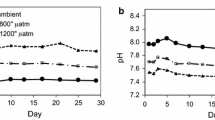Abstract
The relative importance of 3 different sources for biological production of nitrite in seawater was studied. Decomposition of fecal pellets of the copepod Calanus helgolandicus (at a concentration of approximately 12 μg-at N/l), in seawater medium, released small amounts of ammonia over a 6 week period. It nitrifying bacteria were added to the fecal pellets nitrite was barely detectable over the same period. Decomposition of phytoplankton (present at a concentration of about 8 μg-at particulate plant N/l) with added heterotrophic bacteria, released moderate amounts of ammonia over a 12 week period. If the ammonia-oxidizing bacterium Nitrosocystis oceanus was added to the decomposing algae, nitrite was produced at a rate of 0.2 μg-at N/l/week. Heterotrophic nitrification was not observed when 7 open-ocean bacteria were tested for their ability to oxidize ammonia. The diatom Skeletonema costatum, either non-starved or starved of nitrogen, produced nitrite when growing with 150 or 50 μg-at NO -2 -N/l at a light intensity of about 0.01 ly/min. When nitrate in the medium was exhausted, S. costatum assimilated nitrite. If starved of vitamin B12, both non-N-starved and N-starved cells of S. costatum produced nitrite in the medium with 150 μg-at NO -3 -N/l. Nitrate was not exhausted and cell densities reached 2x105/ml due to vitamin B12 deficiency. If light intensity was reduced to 0.003 ly/min under otherwise similar conditions, cells did not grow due to insufficient light, and nitrite was not produced. In the sea, it appears that, in certain micro-environments, decomposition of particulate matter releases ammonia with its subsequent oxidation to nitrite. The amounts of these nutrients and the rate at which they are produced are dependent upon the nature of the materials undergoing decomposition and the associated bacteria. In certain other areas of the sea, where phytoplankton standing stock is high and nitrate is non-limiting, excretion by these organisms is a major source of nitrite.
Similar content being viewed by others
Literature cited
Brandhorst, W.: Nitrification and denitrification in the eastern tropical north Pacific. J. Cons. int. Explor. Mer 25, 3–20 (1959).
Carlucci, A. F. and P. M. Bowes: Production of vitamin B12, thiamine and biotin by phytoplankton. J. Phycol. (1970). (In Press).
— and P. M. McNally: Nitrification by marine bacteria in low concentrations of substrate and oxygen. Limnol. Oceanogr. 14, 736–739 (1969).
— and H. R. Schubert: Nitrate reduction in seawater of the deep nitrite maximum off Peru. Limnol. Oceanogr. 14, 187–193 (1969).
— and J. D. H. Strickland: The isolation, purification, and some kinetic studies of marine nitrifying bacteria. J. exp. Mar. Biol. Ecol. 2, 156–166 (1968).
Fiadeiro, M. and J. D. H. Strickland: Nitrate reduction and the occurrence of a deep nitrite maximum in the ocean off the west coast of South America. J. mar. Res. 26, 187–201 (1968).
Goering, J. J.: Denitrification in the oxygen minimum layer of the eastern tropical Pacific Ocean. Deep Sea Res. 15, 157–164 (1968).
Hamilton, R. D.: Photochemical processes in the inorganic nitrogen cycle of the sea. Limnol. Oceanogr. 9, 107–111 (1964).
Strickland, J. D. H. and T. R. Parsons: A practical handbook of seawater analysis. Bull. Fish. Res. Bd Can. 167, 1–311 (1968).
Thomas, W. H.: On denitrification in the northeastern tropical Pacific Ocean. Deep Sea Res. 13, 1109–1114 (1966).
University of California, Scripps Institution of Oceanography: Data report, URSA Major Expedition. SIO Reference 67-5 (1967).
Vaccabo, R. F. and J. H. Ryther: Marine phytoplankton and the distribution of nitrite in the sea. J. Cons. int. Explor. Mer 25, 260–271 (1960).
von Brand, T., N. W. Rakestraw and C. E. Renn: Experimental decomposition and regeneration of nitrogenous organic matter. Biol. Bull. mar. biol. Lab., Woods Hole 72, 165–175 (1937).
Watson, S. W.: Characteristics of a marine nitrifying bacterium, Nitrosocystis oceanus sp. n. Limnol. Oceanogr. 10 (Suppl.), R274-R289 (1965).
Author information
Authors and Affiliations
Additional information
Communicated by G. L. Voss, Miami
Rights and permissions
About this article
Cite this article
Carlucci, A.F., Hartwig, E.O. & Bowes, P.M. Biological production of nitrite in seawater. Marine Biology 7, 161–166 (1970). https://doi.org/10.1007/BF00354921
Accepted:
Issue Date:
DOI: https://doi.org/10.1007/BF00354921




